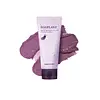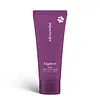What's inside
What's inside
 Key Ingredients
Key Ingredients

 Benefits
Benefits

 Concerns
Concerns

 Ingredients Side-by-side
Ingredients Side-by-side

Solanum Melongena Fruit Extract 66%
Skin ConditioningKaolin 14%
AbrasivePropanediol
SolventDipropylene Glycol
HumectantIsononyl Isononanoate
Emollient1,2-Hexanediol
Skin ConditioningUltramarines
Arachidyl Alcohol
EmollientCetyl Alcohol
EmollientGlyceryl Stearate
EmollientStearyl Alcohol
EmollientBehenyl Alcohol
EmollientCI 77491
Cosmetic ColorantTitanium Dioxide
Cosmetic ColorantJuglans Regia Shell Powder
AbrasiveArachidyl Glucoside
EmulsifyingSalvia Hispanica Seed Extract
EmollientCentella Asiatica Extract
CleansingHouttuynia Cordata Extract
Skin ConditioningPotassium Cetyl Phosphate
EmulsifyingBentonite
AbsorbentBetula Alba Juice
AstringentWater
Skin ConditioningGlyceryl Stearate Se
EmulsifyingEthylhexylglycerin
Skin ConditioningXanthan Gum
EmulsifyingTocopheryl Acetate
AntioxidantButylene Glycol
HumectantDisodium EDTA
Allantoin
Skin ConditioningGlucose
HumectantCalendula Officinalis Flower Extract
MaskingHydroxycinnamic Acid
Skin ConditioningRutin
AntioxidantSolanum Melongena Fruit Extract 66%, Kaolin 14%, Propanediol, Dipropylene Glycol, Isononyl Isononanoate, 1,2-Hexanediol, Ultramarines, Arachidyl Alcohol, Cetyl Alcohol, Glyceryl Stearate, Stearyl Alcohol, Behenyl Alcohol, CI 77491, Titanium Dioxide, Juglans Regia Shell Powder, Arachidyl Glucoside, Salvia Hispanica Seed Extract, Centella Asiatica Extract, Houttuynia Cordata Extract, Potassium Cetyl Phosphate, Bentonite, Betula Alba Juice, Water, Glyceryl Stearate Se, Ethylhexylglycerin, Xanthan Gum, Tocopheryl Acetate, Butylene Glycol, Disodium EDTA, Allantoin, Glucose, Calendula Officinalis Flower Extract, Hydroxycinnamic Acid, Rutin
Water
Skin ConditioningKaolin
AbrasiveDipropylene Glycol
HumectantPropanediol
SolventCetearyl Alcohol
EmollientBentonite
AbsorbentIsononyl Isononanoate
Emollient1,2-Hexanediol
Skin ConditioningArachidyl Alcohol
EmollientGlyceryl Stearate
EmollientMandelic Acid
AntimicrobialCI 77742
Cosmetic ColorantSolanum Melongena Fruit Extract
Skin ConditioningBehenyl Alcohol
EmollientPotassium Cetyl Phosphate
EmulsifyingArachidyl Glucoside
EmulsifyingPotassium Hydroxide
BufferingCI 77891
Cosmetic ColorantCI 77499
Cosmetic ColorantCI 77491
Cosmetic ColorantEthylhexylglycerin
Skin ConditioningCetyl Alcohol
EmollientXanthan Gum
EmulsifyingGlycerin
HumectantDisodium EDTA
Butylene Glycol
HumectantCaprylic/Capric Triglyceride
MaskingHydrogenated Phosphatidylcholine
EmulsifyingCentella Asiatica Extract
CleansingSucrose Stearate
EmollientSodium Hyaluronate
HumectantTocopherol
AntioxidantHyaluronic Acid
HumectantSodium Hyaluronate Crosspolymer
HumectantPotassium Hyaluronate
Skin ConditioningHydroxypropyltrimonium Hyaluronate
Hydrolyzed Hyaluronic Acid
HumectantMadecassoside
AntioxidantMadecassic Acid
Skin ConditioningAsiaticoside
AntioxidantAsiatic Acid
Skin ConditioningSodium Acetylated Hyaluronate
HumectantWater, Kaolin, Dipropylene Glycol, Propanediol, Cetearyl Alcohol, Bentonite, Isononyl Isononanoate, 1,2-Hexanediol, Arachidyl Alcohol, Glyceryl Stearate, Mandelic Acid, CI 77742, Solanum Melongena Fruit Extract, Behenyl Alcohol, Potassium Cetyl Phosphate, Arachidyl Glucoside, Potassium Hydroxide, CI 77891, CI 77499, CI 77491, Ethylhexylglycerin, Cetyl Alcohol, Xanthan Gum, Glycerin, Disodium EDTA, Butylene Glycol, Caprylic/Capric Triglyceride, Hydrogenated Phosphatidylcholine, Centella Asiatica Extract, Sucrose Stearate, Sodium Hyaluronate, Tocopherol, Hyaluronic Acid, Sodium Hyaluronate Crosspolymer, Potassium Hyaluronate, Hydroxypropyltrimonium Hyaluronate, Hydrolyzed Hyaluronic Acid, Madecassoside, Madecassic Acid, Asiaticoside, Asiatic Acid, Sodium Acetylated Hyaluronate
 Reviews
Reviews

Ingredients Explained
These ingredients are found in both products.
Ingredients higher up in an ingredient list are typically present in a larger amount.
1,2-Hexanediol is a synthetic liquid and another multi-functional powerhouse.
It is a:
- Humectant, drawing moisture into the skin
- Emollient, helping to soften skin
- Solvent, dispersing and stabilizing formulas
- Preservative booster, enhancing the antimicrobial activity of other preservatives
Arachidyl Alcohol is a fatty alcohol made from peanut oil. It is an emollient, emulsifier, and thickener.
You'll most likely find this ingredient as an emulsifier in water-based cosmetics.
We don't have a description for Arachidyl Glucoside yet.
Behenyl Alcohol is a type of fatty alcohol (these are different from the drying, solvent alcohols).
Fatty Alcohols have hydrating properties and are most often used as an emollient or to thicken a product. They are usually derived from natural fats and oils; behenyl alcohol is derived from the fats of vegetable oils.
Emollients help keep your skin soft and hydrated by creating a film that traps moisture in.
In 2000, Behenyl Alcohol was approved by the US as medicine to reduce the duration of cold sores.
Learn more about Behenyl AlcoholBentonite is an aluminium phyllosilicate clay with great absorbent properties. The name 'bentonite' comes from the area where the largest source is found: Fort Benton, Wyoming.
As a clay, bentonite is often used to absorb excess oil and provide exfoliation. It has also been shown to have some antibacterial and anti-inflammatory properties. Studies show bentonite was effective at calming dermatitis from poison ivy and in diaper dermatitis of infants. Bentonite has also been shown to act as a barrier against toxic compounds on your skin.
Sunscreens containing bentonite display higher water resistance and stay on the skin for much longer. The sunscreens containing bentonite also show higher potency and UV light absorbtion.
Bentonite is naturally created from volcanic ash and several natural weathering/hydrothermal processes.
A common usage of bentonite is removing excess protein from white wines. Bentonite contains a property of being able to absorb large amounts of protein from aqueous solutions.
Phyllosilicate clay has a structure formed by sheets.
Learn more about BentoniteButylene Glycol (or BG) is used within cosmetic products for a few different reasons:
Overall, Butylene Glycol is a safe and well-rounded ingredient that works well with other ingredients.
Though this ingredient works well with most skin types, some people with sensitive skin may experience a reaction such as allergic rashes, closed comedones, or itchiness.
Learn more about Butylene GlycolCentella Asiatica Extract (Centella) is derived from an herb native to Southeast Asia. It is famous for its anti-inflammatory and soothing properties.
Centella is rich in antioxidants and amino acids, such as Madecassic Acid and Asiaticoside.
Studies show the compounds in centella help with:
The combination of all these properties makes centella effective at soothing, hydrating, and protecting the skin.
Other great components of centella include Vitamin A, vitamin C, several B vitamins, and Asiatic Acid.
Fun fact: Centella has been used as a medicine and in food for many centuries. As a medicine, it is used to treat burns, scratches, and wounds.
Learn more about Centella Asiatica ExtractCetyl Alcohol is a fatty alcohol. Fatty Alcohols are most often used as an emollient or to thicken a product.
Its main roles are:
Though it has "alcohol" in the name, it is not related to denatured alcohol or ethyl alcohol.
The FDA allows products labeled "alcohol-free" to have fatty alcohols.
Learn more about Cetyl AlcoholCi 77491 is also hydrated iron III oxide. It's sole purpose is to give a red/pink hue to products.
Iron III oxides are classified as inorganic chemicals for coloring.
Synthetically created Ci 77491 is considered safer than those naturally found. This is because the synthetically created version may contain less impurities. Iron oxides are generally non-toxic and non-allergenic.
Learn more about CI 77491Dipropylene Glycol is a synthetically created humectant, stabilizer, and solvent.
This ingredient helps:
Dipropylene glycol is technically an alcohol, but it belongs to the glycol family (often considered part of the ‘good’ alcohols). This means it is hydrating and gentle on skin unlike drying solvent alcohols like denatured alcohol.
As a masking agent, Dipropylene Glycol can be used to cover the smell of other ingredients. However, it does not have a scent.
Studies show Dipropylene Glycol is considered safe to use in skincare.
Learn more about Dipropylene GlycolDisodium EDTA plays a role in making products more stable by aiding other preservatives.
It is a chelating agent, meaning it neutralizes metal ions that may be found in a product.
Disodium EDTA is a salt of edetic acid and is found to be safe in cosmetic ingredients.
Learn more about Disodium EDTAEthylhexylglycerin (we can't pronounce this either) is commonly used as a preservative and skin softener. It is derived from glyceryl.
You might see Ethylhexylglycerin often paired with other preservatives such as phenoxyethanol. Ethylhexylglycerin has been found to increase the effectiveness of these other preservatives.
Glyceryl Stearate is a mix of glycerin and stearic acid.
It is used to stabilize the mixing of water and oil ingredients. By preventing these ingredients from separating, it can help elongate shelf life. It can also help thicken the product's texture.
As an emollient, it helps soften skin and supports barrier-replenishing ingredients.
In cosmetics, Glyceryl Stearate is often made from vegetable oils or synthetically produced.
This ingredient may not be fungal-acne safe
Fun fact: The human body also creates Glyceryl Stearate naturally.
Learn more about Glyceryl StearateIsononyl Isononanoate is a synthetic skin-conditioner and texture enhancer. It is created from nonanoic acid, a fatty acid found in cocoa and lavender oil.
As an emollient, Isononyl Isononanoate helps keep your skin soft and smooth. This is because emollients create a barrier on the skin to trap moisture in.
Isononyl Isononanoate helps give products a velvet feel and improves spreadability.
Learn more about Isononyl IsononanoateKaolin is a clay. It is used for oil control and to help minimize pores. Like other clays, kaolin has the ability to absorb excess sebum or oil. This can help clean out pores and mattify the skin.
Some types of kaolin may have exfoliating properties. When water is added to kaolin, it becomes a paste with small abrasive particles.
Most kaolin is a white color, but may be pink/orange/red depending on where it comes from.
The name 'kaolin' comes from a Chinese village named 'Gaoling'. Kaolin clay comes from rocks rich in kaolinite. Kaolinite, the mineral, has a silicate layered structure. Kaolinite is formed from chemical weathering of aluminum siilicate minerals.
Besides skincare, kaolin is commonly used to make glossy paper, in ceramics, toothpaste, and as medicine to soothe stomach issues.
Learn more about KaolinPotassium Cetyl Phosphate is the potassium salt of a mixture. This mixture consists of the esters from phosphoricacid and cetyl alcohol.
Potassium Cetyl Phosphate is an emulsifier and cleansing agent. Emulsifiers help stabilize a product. It does this by preventing certain ingredients from separating.
As a cleansing agent, Potassium Cetyl Phosphate helps gather oils, dirts, and pollutants from your skin. This makes it easier to rinse them away with water.
Learn more about Potassium Cetyl PhosphatePropanediol is an all-star ingredient. It softens, hydrates, and smooths the skin.
It’s often used to:
Propanediol is not likely to cause sensitivity and considered safe to use. It is derived from corn or petroleum with a clear color and no scent.
Learn more about PropanediolWe don't have a description for Solanum Melongena Fruit Extract yet.
Water. It's the most common cosmetic ingredient of all. You'll usually see it at the top of ingredient lists, meaning that it makes up the largest part of the product.
So why is it so popular? Water most often acts as a solvent - this means that it helps dissolve other ingredients into the formulation.
You'll also recognize water as that liquid we all need to stay alive. If you see this, drink a glass of water. Stay hydrated!
Learn more about WaterXanthan gum is used as a stabilizer and thickener within cosmetic products. It helps give products a sticky, thick feeling - preventing them from being too runny.
On the technical side of things, xanthan gum is a polysaccharide - a combination consisting of multiple sugar molecules bonded together.
Xanthan gum is a pretty common and great ingredient. It is a natural, non-toxic, non-irritating ingredient that is also commonly used in food products.
Learn more about Xanthan Gum